
The case of RUTH McCLAMMA STUEVE et al., v. BUCHALTER NEMER et al., answered this very question. The Stueve case stated: Generally, an action must be “brought to trial” within five years of the filing of a civil complaint. (Code Civ. Proc., § 583.310, et seq.) 1 If the time period is not tolled by statute, the case must be dismissed. (§§ 583.340, 583.360.) “In an action tried to a jury, the action is brought to trial when the jury is impaneled and sworn.” (Bruns v. E-Commerce Exchange, Inc. (2011) 51 Cal.4th 717, 723) (Bruns), italics added.) Here, with just three days remaining before the fifth anniversary of the filing of a civil complaint, a panel of 75 prospective jurors assembled in a courtroom for jury selection (voir dire). The court clerk administered an oath and the panel swore to give truthful answers. Seven days later, while voir dire was still in progress, defendants moved to dismiss under the five-year dismissal statute. The trial court granted the motion, finding that the jury had not yet been “impaneled and sworn.” We reverse. The jury was “impaneled” when the panel of prospective jurors assembled in the courtroom for voir dire. The panel was “sworn” when the prospective jurors took an oath to respond truthfully. Accordingly, the action was, in fact, “brought to trial” within five years of the filing of the civil complaint. Thus, the trial court should not have granted defendants’ motion to dismiss.
The Court noted that when the jury is assembled in the courtroom for voir dire, they are given the “oath of truthfulness.” However, once selected, the jury is sworn a second time to “try the cause.”
In this regard, the Stueve Court held:
The word “impaneled” is not defined within the Act, but generally means: “The act of the clerk of the court in making up the list of jurors who have been selected for the trial of a particular cause. All the steps of ascertaining who shall be the proper jurors to sit in the trial of a particular case up to the final formation.” (Black’s Law Dict. (6th ed. 1990) p. 752, cols. 1 & 2.)The word “sworn” is similarly not defined within the Act, but generally means providing an affirmative response to an oath or affirmation. (§ 2093 [a judge or a court clerk may “administer oaths or affirmations”].) Based on the foregoing, we conclude that a jury is impaneled when the jury trial panel of prospective jurors is assembled in a courtroom for the purposes of voir dire. We note that the word “panel” is used consistently throughout the statutes and refers exclusively to the “prospective juror[s],” not the final “trial jurors.” Further, we conclude that a panel is sworn when the court (usually the court clerk) administers the initial oath of truthfulness and the panel collectively responds, “I do.” Although the actual trial jurors will ultimately be sworn again—this time to try the cause—that does not negate the fact that the panel was sworn at the beginning of voir dire. Accordingly, in this case the jury was impaneled and sworn on September 21, 2015, at the beginning of voir dire.
